- Bernard Preston homepage
- Starch
- About Resistant Starch
About resistant starch
This short essay about resistant starch explains where it is found and why it is so good for us.
Plant-starches are found in many foods like potatoes, grains such as oats and wheat; in smaller amounts in legumes too. They contain two different types of carbohydrate.
- Amylose makes up about a quarter.
- Amylopectin makes up the other three-quarters.
They are quite different. Amylose consists of long chains of glucose molecules linked together in what is known as a polysaccharide; the number of sugar-units varies from hundreds to several thousand depending on the source of the starch.
Amylopectin is highly branched.
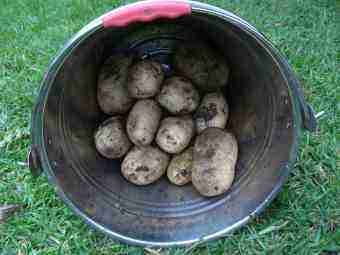
Amylose
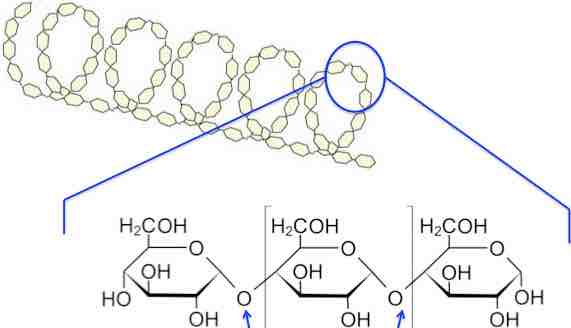 A long chain of glucose molecules in a helical structure
A long chain of glucose molecules in a helical structureIn amylose this long chain has a twisted or helical configuration that makes it difficult for enzymes to reach the glucose units; free molecules are less readily formed and more of the food tends to reach the large intestine for fermentation by the normal flora instead. It is unlikely to raise your blood sugar dramatically; unless you are insulin-resistant.
This page was last updated by Bernard Preston on 6th March, 2024.
New potatoes interestingly as compared to those from cold storage are also more resistant to the enzymes in the small intestine; much passes through to the large bowel where friendly short-chain fatty acids are produced instead of glucose. They have a profoundly good effect on our immune systems; and supply energy to the cells lining the gut.
Amylopectin
Amylopectin is the three quarters fraction of starch; it is soluble in water. It consists of short, highly-branched chains which are readily digested by enzymes starting in the mouth and then the small intestine.
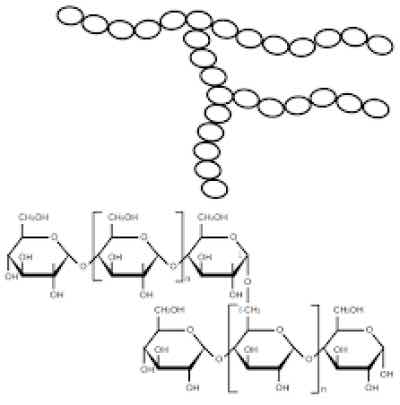 Rapidly digested branched amylopectin
Rapidly digested branched amylopectinThen the many thousands of glucose molecules are ready for immediate absorption; and cause a rapid rise in blood sugar. This puts a huge strain on the liver which has to suck up all this carbohydrate that one has just eaten.
In nutritional terms it is called "chronic excessive carbohydrate consumption." It is the true cause of obesity particularly if it is mainly refined-starch; or has a high amylopectin fraction.
That is excellent if you are an athlete but not if you sit behind a computer for most of the day.
After about two decades there is great risk of developing type 2 diabetes and non-alcoholic steatohepatitis; fibrosis of the tissues caused by fatty liver disease.
This is complex stuff but bear with me if you want to be able to enjoy more energy; and in particular if you are obese and tired of the loss of well-being that goes with it.
Three types of starch
- Rapidly-digested starch
- Slowly-digested starch
- Resistant-starch
The colossal problem with modern Western food is that it consists in the main of rapidly digested starches. Examples are boiled potato, french fries and short-grain rice, especially if it is precooked. They have a strongly glycemic effect; read a very high GI.
They are rich in amylopectin; it spikes your blood glucose.
Do note that new potatoes do not fall into this category but they are hard to get unless you grow them yourself; and unfortunately the plant is usually browned off with a herbicide. They must not have come from cold-storage. You should be able to easily scrape the skin off with your thumbnail.
Commercial potatoes are also sprayed with toxic-herbicides like paraquat and glyphosate just before harvesting to kill off the haulm; these chemicals damage the microbiome[8]. We recommend growing them yourself if you have a large enough garden.
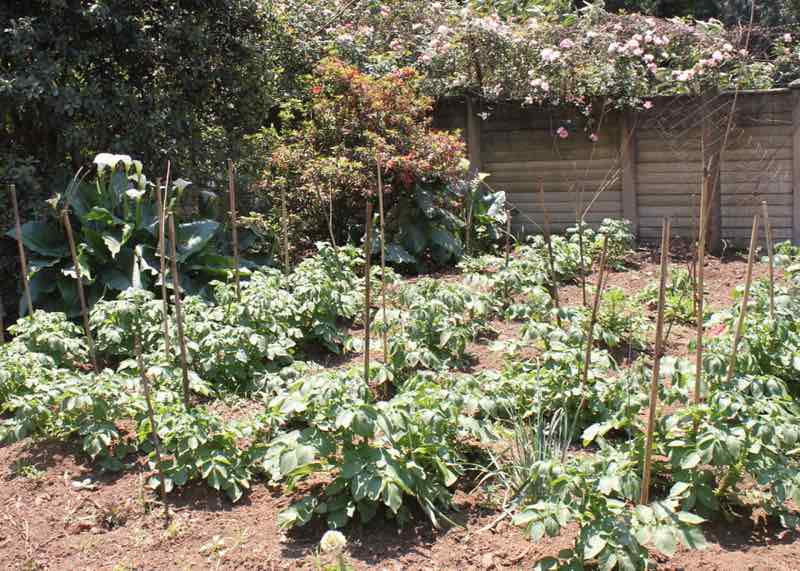 Grow your own potatoes
Grow your own potatoesResistant starch on the other hand is not absorbed in the small intestine as it is high in the helical amylose; which enzymes are slower to digest.
It reaches the colon where it is fermented by the microflora; the bugs are able to break down these foods which are then assimilated more slowly in the large bowel, not as glucose but as nutritious short-chain fatty acids.
These bacteria and yeasts also produce various gases which may cause flatulence which is quite normal and to be expected.
In order for this to happen normally, a broad-spectrum of the microflora is necessary. In fact researchers are finding that many of the diseases of our modern world have their origin in a deficiency of these supportive bugs in the intestine.
One can take tablets called probiotics but it is very easy to get them from your food. Just five-minutes work every morning will provide your family with what is needed; read more about kefir benefits.
Oddly one friend who started enjoying kefir daily reported much less gas passed.
About resistant starch
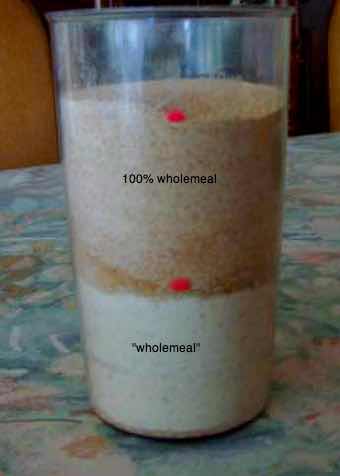
To sum up this page about resistant starch describes how some carbohydrates are broken down in the small intestine giving an immediate and unwelcome surge in blood glucose; but others pass through to the colon for fermentation.
In the colon they are acted upon by these wonderful bacteria, yeasts and viruses also known as the normal flora. They live there specifically to digest this resistant starch and turn it into various fatty acids like butyrate; google this substance as it acts as a very important anti-inflammatory substance in the body. That means less angry blood vessels, muscles and joints.
Those profoundly good bugs that live in the colon incidentally are called the microbiome; in order to flourish they need plenty of resistant starch which has escaped the attention of the enzymes in the small intestine.
In modern lingo that carbohydrate reaches the colon where it is known as a prebiotic; along with any indigestible fibre. There they are fermented by these friendly bugs and turned not into glucose but the short-chain fatty acids like butyrate.
The beauty of resistant starch is that it reduces the risk of getting type-2 diabetes; and in fact ameliorates the effect of the disease if you already have it. This is because it does not cause the surge in blood sugar, demanding an immediate spurt of insulin which stores that glucose as adipose.
That is what happens to rapidly-digested starches; they make us fat.
Interesting research shows that soluble fibre found in unrefined oats, for example, has a significant ameliorating effect on the insulin spike; just as the resistant starch reduces the glucose. They work together having a wonderfully beneficial influence[1].
It is also because of that butyrate which has an anti-inflammatory effect on the pancreas too; helping to prevent autoimmune diseases like diabetes. Don't take it in supplements but rather let your food be your medicine. If you know about resistant starch, the friendly bugs in your colon will produce plenty of it for free.
So how do we get more resistant starch onto our plates?
Processed starches
It comes as no surprise that the more food manufacturers process our grains and potatoes, the greater the amount of rapidly-digested starch it will contain.
Whole grains like unprocessed wheat contains 14% of resistant starch that will reach the colon. Conversely refined cake-flour has 2 percent or less; the carb is rapidly absorbed in the small intestine, spiking the blood sugar.
"When energy intake exceeds metabolic needs and disposal capacity, carbohydrates in the form of dietary sugars such as fructose, sucrose and glucose drive the formation and accumulation of intrahepatic fat from de novo lipogenesis."
Hepatic de novo lipogenesis is the process in which fatty acids are produced by the cells of the liver from sugars taken up by chronic, excessive refined carbohydrate consumption.
This is the cause of non-alcoholic fatty liver disease.
Don't eat puffed wheat
Let's consider a few facts and figures. A serving of puffed wheat is considered to be 3/4 cup, with a mass of 15g. Shall we compare it with the whole grain?
ingredient
- Fat
- Carb
- Fibre
- Protein
- Price
Puffed wheat
- 0
- 12g
- 2g
- 2g
- 62c/oz = $21,70/kg
Whole grain wheat
- 0.33
- 10.1
- 1.6
- 2.0
- 30c/kg
Don't concern yourself with the small discrepancies in carb, fibre and protein; marginal differences.
But 20% of the fibre and all the excellent lipids have been extracted from the puffed wheat together with the fat-soluble nutrients such as vitamin E.
So millers purchase wheat for 30 U.S. cents/kg, process it and remove the fat; and an unknown percentage of the phytonutrients. Then they sell it back to you for $21.70 per kilogramme. The packaging costs them more than the food in the box.
The same is true of cornflakes.
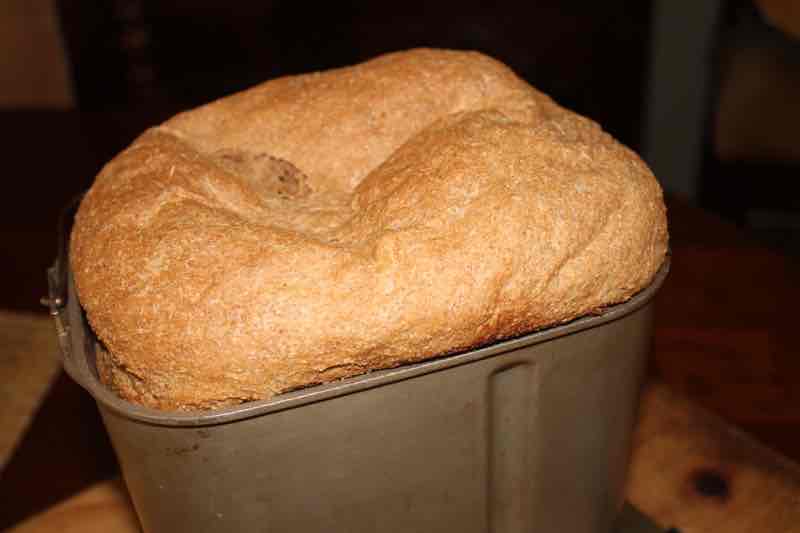 100pc wholemeal sourdough bread.
100pc wholemeal sourdough bread.One slice of this 100% wholegrain sourdough bread weighs 75g; five times more than a helping of puffed wheat.
If you purchase the grain directly from the farmer, that slice costs 3 U.S. cents. But you do need a small mill and a bread machine; and five minutes every morning to grind the flour and mix the dough. That's all it takes; I have done it daily for the last 30 years of my life; except for a period whilst living in the Netherlands.
Why would you eat very costly puffed wheat from which much of the goodness has been extracted when you could bake your own artisan bread?
My own experimentation shows that even wholesome 100% full grain bread still gives a surge in my blood glucose to unacceptably high levels; even with just plain butter. Eaten with a salad that is another matter; the extra fibre slows gastric emptying and stimulates the secretion of the incretin hormones. But this sharp rise can also be completely countered by a brisk ten-minute walk after the meal.
That is
because 86% of the starch even in true wholemeal-bread is still made up
of unresistant carbohydrate; it turns to sugar so you must burn it or
you'll find pounds being layered on in the wrong places.
Over and above whole grains, legumes like peas and beans have a large amount of resistant starch; and seeds such sunflower and flax too. The enzymes in the small-intestine are slower getting to the carbohydrate in unrefined foods.
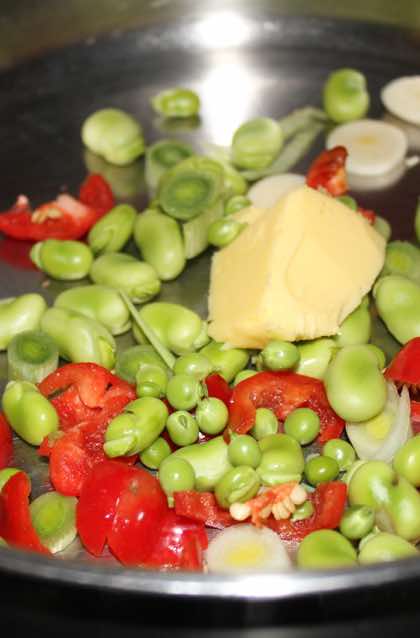
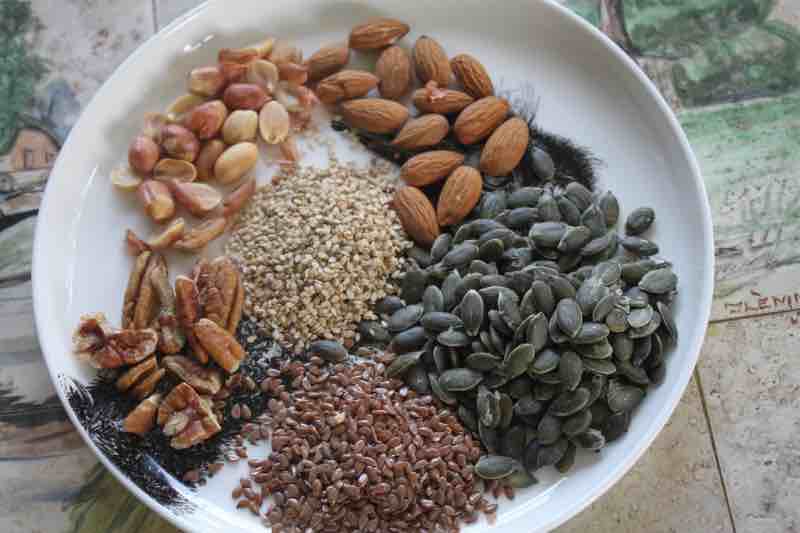
These are known as prebiotics. Don't fall prey to supplement companies and spend a fortune buying them in capsules; just eat more unrefined-foods.
And let them cool first, preferably overnight in the fridge for tomorrow's meals; retrogradation. Every baker will tell you that bread is not at its best straight from the oven.
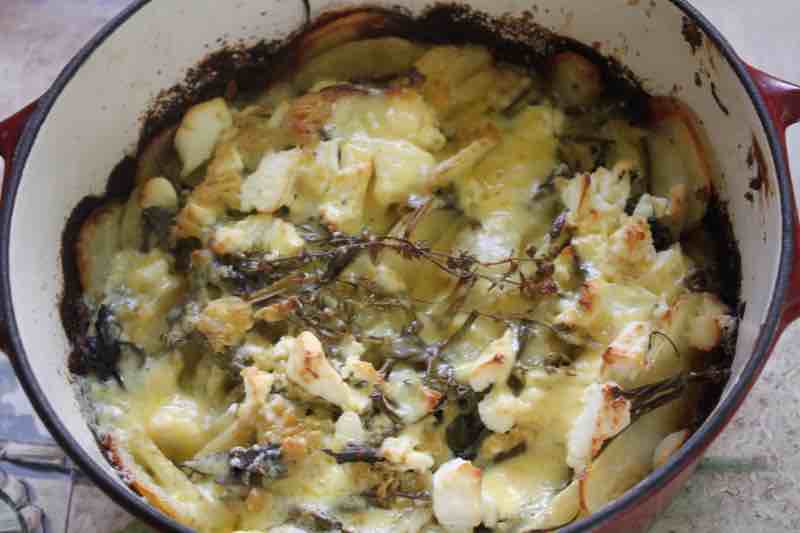 Cheesy potato gratin is best enjoyed tomorrow.
Cheesy potato gratin is best enjoyed tomorrow.Retrogradation is the other way to reduce the rapidly-absorbed fraction; boiled potato is very quickly digested in the small intestine, spiking blood sugar and demanding a spurt of insulin. The glucose is immediately deposited in all the wrong places. It makes us fat.
But take that boiled potato, cool it overnight and then enjoy it hot or cold; far more of the carb reaches the colon for fermentation. Knowing about resistant-starch has profound implications for the good housewife.
Add some vinegar or fresh lemon juice and you make your chilled potato-salad even more resistant to instant digestion in the small intestine.
Look out for the cooking time on the package. A pasta, oats or rice that requires long boiling will have far more resistant starch in it.
Avoid the precooked stuff; it makes you fat because it's easily acted on by enzymes in the small intestine and rapidly absorbed into the blood-stream.
Elsewhere we'll look at new potatoes that have far more resistant-starch in them.
Fibre
The fibre in our meals is also made up of polysaccharides but our bodies do not secrete the enzymes necessary to digest these sugars; they pass through the small intestine unchanged.
Some of the fibre is fermented in the colon by the friendly flora producing those very important short-chain fatty acids. These polysaccharides are often called pre-biotics; food for the teeming billions of bacteria and yeasts in the large bowel[4].
Fibre is also called the "non-starch" component of our food. Pectin is an example, familiar to every jam maker.
Understanding how net carbs work will be a big part of your progress in dealing with obesity.
Why is 100% whole grain better? None of the fibre, germ or vitamins have been extracted.
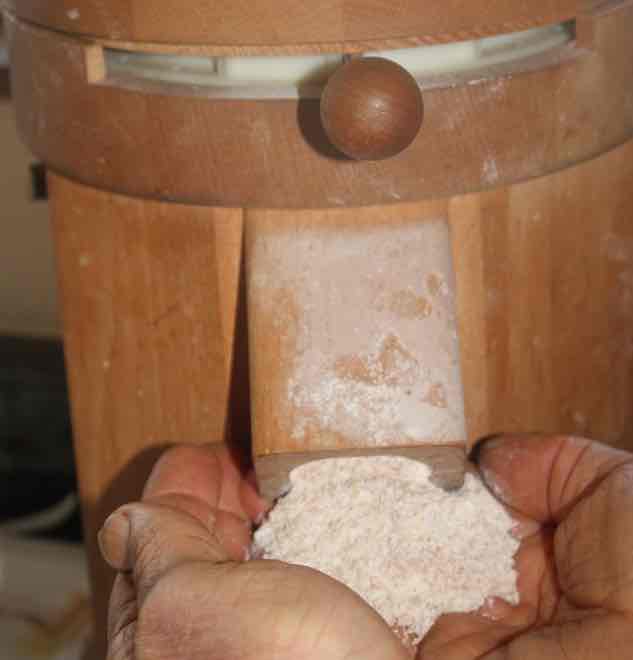 True wholemeal, no separation of the three streams
True wholemeal, no separation of the three streamsSteel-cut and rolled oats
Unprocessed steel-cut and rolled oats are one of the best examples of resistant starch; the finest remedy for high cholesterol. They are also an excellent solution to insulin resistance; it hardly affects the postprandial blood glucose, especially if you take a short, brisk walk after breakfast.
A cup of unprocessed raw oats has 17.6g of resistant starch which would pass through to the colon.
But food manufacturers grind it finely, remove much of the bran and precook it; that reduces that whole grain into a porridge containing only 0.5g of resistant starch. Most of it is instead digested in the small-intestine producing glucose.
These Quaker oats recipes should be a basic on everyone's shopping list. They make the kinds of meals that grandma would have offered and are still the best; but not the refined stuff that comes in a box.
In short large prospective studies prove that a higher whole-grain consumption reduces the risk of death from chronic conditions such as type 2 diabetes and cardiovascular disease.[2]
On the other hand refined grains increase the risk of diabetes and cardiovascular-disease because they make you fat and there's little butyrate produced by the normal flora in the colon; the bugs are being starved of resistant starch.
Legumes
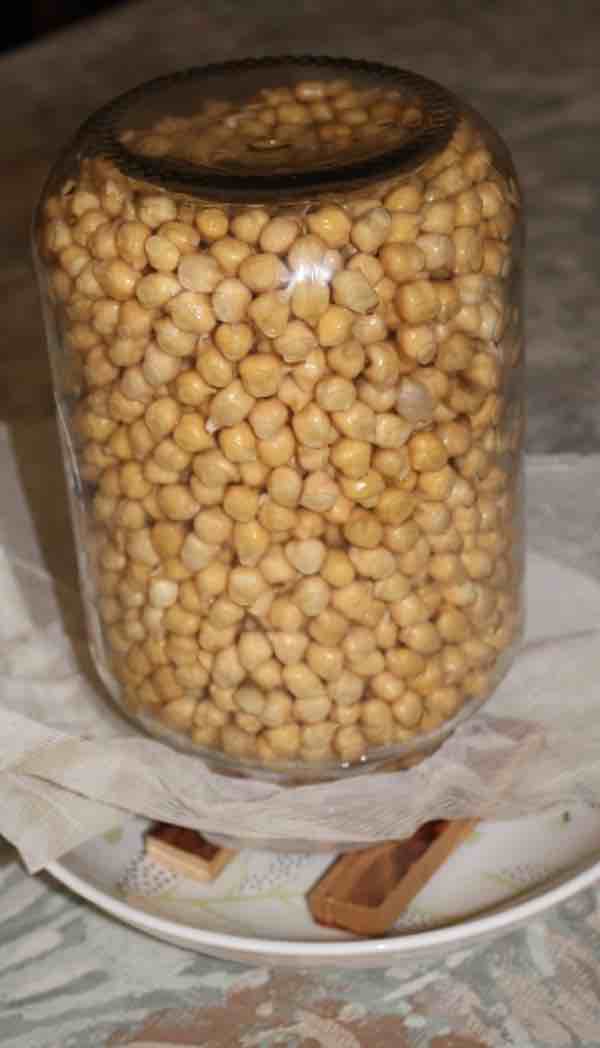
Legumes like chickpeas and beans have large amounts of resistant fibre, but they need to be soaked, rinsed several times and preferably sprouted; and even fermented to remove so-called anti-nutrients.
As soon as you start investigating the subject about resistant-starch, you begin to realise it is profoundly complex. When you buy legumes like chickpeas in a can, you have no idea how they have been prepared; certainly they would not have been sprouted or fermented, and probably not soaked and rinsed adequately either. It is important to get the lectins out.
Rinsing and soaking several times can be done overnight, followed by another three days of sprouting chickpeas; the actual work-time taken is perhaps fifteen minutes to give you enough for homemade hummus for a month.
Cooking chickpeas is not difficult, but it does take some time which is why we should prepare several pounds on each occasion and freeze them.
It is a lot simpler with a pressure-cooker. Keep back some to make a chickpea soup recipe; divine and full of resistant starch.
Microbiota
There is a profound body of research now showing that the friendly bacteria, viruses and yeasts in the gut have an enormously beneficial influence not only on our immune-system but also on distant organs like the brain, lungs and skin.
Rural children enjoying food high in plant starches, legumes for amino-acids and less red meat have four times the level of beneficial short-chain fatty acids, as compared to Western kids. Their meals consist predominantly of animal protein, sugar and refined carbohydrate; high in fat and low in fibre too. That radically changes the microflora in their alimentary canals for the worse; both the number and the diversity.
That production of SCFA lowers the pH in the gut makes it less hospitable to pathogens like E. coli.
These SCFA are of three types; acetate, proprionate and butyrate. The names are not important but their function certainly is. Since they circulate throughout the whole body, via the immune system they give one protection against an unwanted inflammatory response in all organs; hence their profound influence on the brain and lungs, for example.
These SCFAs also provide up to 10% of our caloric requirements with no insulin response; hence the role they play in metabolic disorders like obesity and diabetes[3].
Ketogenic diets
Learning about resistant starch, truly grasping it and incorporating this new way of life into your meal planning, will mean that you will most likely not have to start thinking about the ketogenic diets; or far worse still those where you have to count calories.
Starches are important nutrients but food companies mess them up so badly that they make us obese and diabetic. Grasp the nettle, prickly though it may be, totally cut out the refined carbs and manage the others correctly; then we need have no fear of them, nor the serious loss of wellness that they cause to so many.
- How to plant potatoes.
- Resistant Starch Content of potatoes[7]
- Panera bread menu recipe
- Easy lunch recipes
Melanoma treatment
Melanoma is a particularly difficult malignancy since it spreads both via the blood and the lymphatics. A novel new treatment is known as "immune checkpoint blockade."
However it is associated with a range of immune-related adverse responses.
"Preclinical studies have shown immunomodulatory and antitumor activities of several nutrients, including fiber, polyphenols and antioxidants,that are mediated via the gut microbiome."
- JAMA network [6]
Resistant starch from dietary fibre in the Mediterranean diet resulting in large amounts of short-chain fatty acids was associated with a better response to ICB treatment.
Non-alcoholic fatty liver disease
Non-alcoholic fatty liver disease occurs when such large quantities of sugars are delivered to the liver that the organ is not able to use and dispose of them fast enough; so it accumulates as lipids in the hepatocytes.
Type-2 diabetes is the greatest risk factor for the development of NAFLD, liver fibrosis and cancer[5].
Making certain we are consuming more resistant starch and less that is refined and rapidly digested, producing large amounts of sugars in the portal blood stream is the way to prevent this serious liver disease; together with daily exercise.
Short cuts
Much to our dismay there are no short cuts to wellbeing. What is astonishing is that so desperate are some to shed unwanted pounds, but equally determined not to alter their lifestyle, that they would risk the serious side effects of Meridia and amphetamines, for example in some weight-loss products; or even bariatric surgery. Rather find out about resistant starch.
Baros means "reclaiming life." But it's a very painful and relatively dangerous procedure with 4% chance of major complications.
Worse these products, drugs and bariatric surgery are very expensive. Beware if you value your life.
- Consumption of both resistant starch and beta-glucan improves postprandial plasma glucose and insulin in women.
- Association between whole grain intake and risk of mortality: two large prospective studies in US men and women.
- Food, Microbiota and Gut-Lung Connection
- Food Polysaccharides. Web: http://www.vivo.colostate.edu/hbooks/pathphys/digestion/basics/polysac.html
- Practice Guidance on the Clinical Assessment and Management of Nonalcoholic Fatty Liver Disease
- Association of a Mediterranean Diet With Outcomes for Patients Treated With ICB for Advanced Melanoma
- Resistant starch content of potatoes
- Gut microbiota and neurological effects of glyphosate
When browsing use right click and "Open Link in New Tab" or you may get a bad gateway signal.
Newsletter
Our newsletter is entitled "create a cyan zone" at your home, preserving both yourself and Mother Earth for future generations; and the family too, of course. We promise not to spam you with daily emails promoting various products. You may get an occasional nudge to buy one of my books.
Here are the back issues.
- Lifestyle and ideal body weight
- What are ultra-processed foods?
- Investing in long-term health
- Diseases from plastic exposure
- Intensive lifestyle management for obesity has limited value
- A world largely devoid of Parkinson's Disease
- The impact of friendly bacteria in the tum on the prevention of cancer
- There's a hole in the bucket
- Everyone is talking about weight loss drugs
- Pull the sweet tooth
- If you suffer from heartburn plant a susu
- Refined maize meal and stunting
- Should agriculture and industry get priority for water and electricity?
- Nature is calling
- Mill your own flour
- Bake your own sourdough bread
- Microplastics from our water
- Alternative types of water storage
- Wear your clothes out
- Comfort foods
- Create a bee-friendly environment
- Go to bed slightly hungry
- Keep bees
- Blue zone folk are religious
- Reduce plastic waste
- Family is important
- What can go in compost?
- Grow broad beans for longevity
- Harvest and store sunshine
- Blue zone exercise
- Harvest and store your rainwater
- Create a cyan zone at your home
Did you find this page interesting? How about forwarding it to a friendly book or food junkie? Better still, a social media tick would help.
- Bernard Preston homepage
- Starch
- About Resistant Starch
Address:
56 Groenekloof Rd,
Hilton, KZN
South Africa
Website:
https://www.bernard-preston.com
